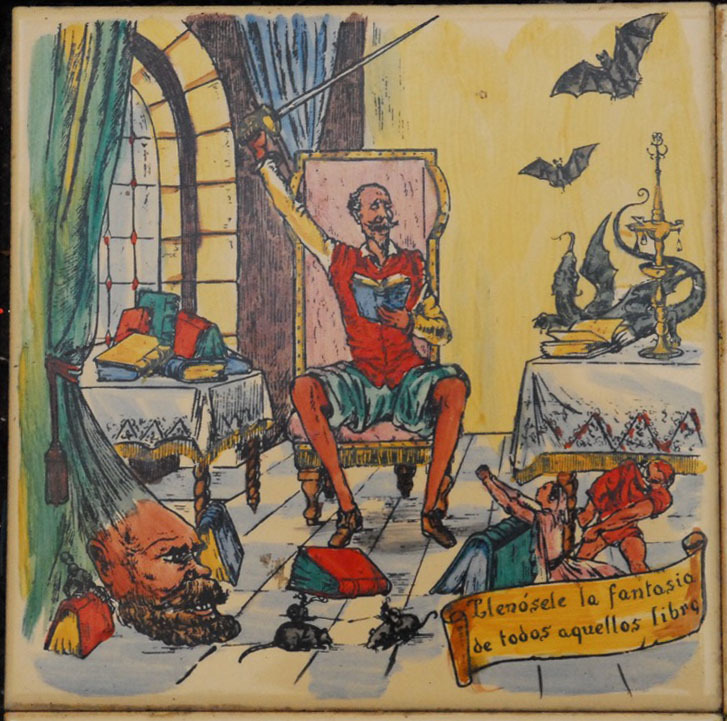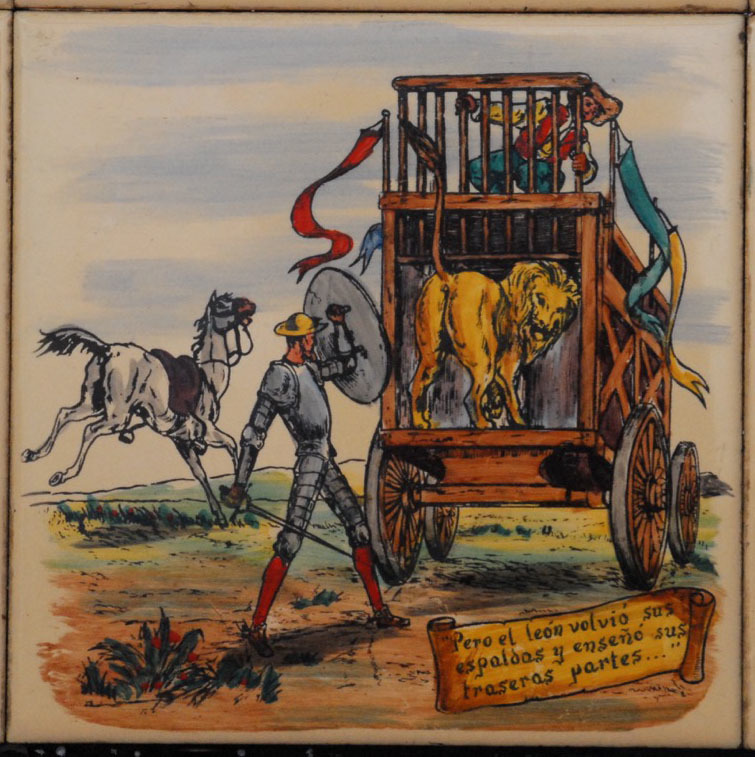Analysis of a Don Quijote Mosaic Table
Don Quijote has proven to be literary masterpiece, but it has also proven throughout time to be representative of Spanish identity. Don Quijote has surpassed his status as literary character and reached a status of cultural icon. This has allowed for a certain opportunity within Spanish tourism: the image of Don Quijote can now be sold. The following pictures are of a decorative iron table, whose surface is composed of artistic tiles that chronicle the adventures of Don Quijote. The artist is Arturo Ballester, an illustrator from Valencia. The tiles were manufactured by Forner sometime during the middle of the twentieth century; the specific date is unknown. This particular table was bought in a touristic market in Madrid. The tiles are hand painted in a Talavera style. Each tile represents an iconic scene of Don Quijote and below the scene, the artist has included a brief description.
Even just the scenes that were chosen give insight to the function of this table. The scenes are chosen because they have become iconic and universally known. The table functions as an almost abridged version of the novel. Amongst the scenes portrayed are Don Quijote’s knighting ceremony in the inn, Don Quijote’s adventures in the cave of Montesinos, and Sancho's being tossed in the air by the people in the inn. These scenes have proven to be more famous than others; their artistic representations are more common that those of other scenes. Perhaps this is because of the lively image the text creates surrounding these key scenes.
The tiles are laid out in chronological order; therefore, the first tile details Don Quijote in his house, reading his books of chivalry. The caption at the bottom reads: “Llenósele la fantasía de todos aquellos libros.” This is a paraphrase of the original text that reads as such: “Llenósele la fantasía de todo aquello que leía en los libros.” This sentence has been translated as: “His fantasy filled with everything he had read in his books.” The tile itself depicts Don Quijote reading a book of chivalry, whilst his surroundings blend with his new fantastical world. Images from the books he has read appear to be in his room, but the author makes it very clear that these are fantastical apparitions. He does this by presenting these images in a surreal way that indicates the fictitious nature of these images. For example, the two people in the lower right hand corner are very small and, therefore, cannot be real. The other very clear example is the head that emerges from the curtains, obviously indicating a fantastical situation. This is the manner in which Ballester introduces the viewer to Don Quijote’s world.
This next tiles depicts probably the most famous scene of all of Don Quijote, or at least the most referenced. It is Don Quijote’s attack of the windmills. The caption in this one cites the book: “y dándole una lanza—da en el aspa,” which is translated as: “and as he thrust his lance into the sail.” Once again the viewer notes a blending of fantasy with reality. The texture of the windmill Don Quijote fights does look like a monster. But the windmill in the background maintains its appearance as a regular windmill. The artist represents both reality and fantasy; what Sancho sees and what Don Quijote sees. This tile manages to represent the duality that is presented to readers in the original text.
This tile represents a scene that occurs much later in the novel: Don Quijote’s attempted fight against a lion. The caption reads: “Pero el león volvió sus espaldas y enseñó sus traseras partes…” This is a slight paraphrase of the original, only altered for brevity’s sake. It is translated as such: “he turned his back, and showed his hindquarters to Don Quijote.” This image is particularly interesting because Don Quijote is presented in a very dignified manner. His stature is tall, powerful, and strong. The tile still retains humoristic elements; choosing to depict the lion as he shows Don Quijote his rear. In the original text, the lion keeper is also present in this scene, but Ballester chooses to include only Don Quijote and Sancho Panza. This perhaps creates a more iconic scene since only the central characters are depicted as present. Again, Don Quijote’s dignified pose is what is most striking about this image. It is almost representative of what Don Quijote’s believes he looks like.
The is the last tile of the table, indicating the last major scene of the novel. It is Don Quijote in his death bed. The caption reads: “Después de su loca vida de andanzas, Don Quijote era cuerdo.” Unlike the other captions, this one does not appear to paraphrase an actual quote from the book. I would translate the caption as: “After his crazy life of adventures, Don Quijote was sane.” It is very interesting that the final tile does not speak to Don Quijote (or rather Alonso Quijano’s) death. The tile only mentions Don Quijote’s return to sanity. Ballester chooses to kill only one character, Don Quijote. He does not kill Alonso Quijano. The image connotes that he is in his death bed, but his death is not clearly stated and someone who has not read the book, could easily believe that Alonso Quijano continued living. Perhaps this is the intent of Ballester, to rewrite the ending of Don Quijote so that some trace of Don Quijote can continue to live and create adventures.
-- Gabriela Lomba Guzman




